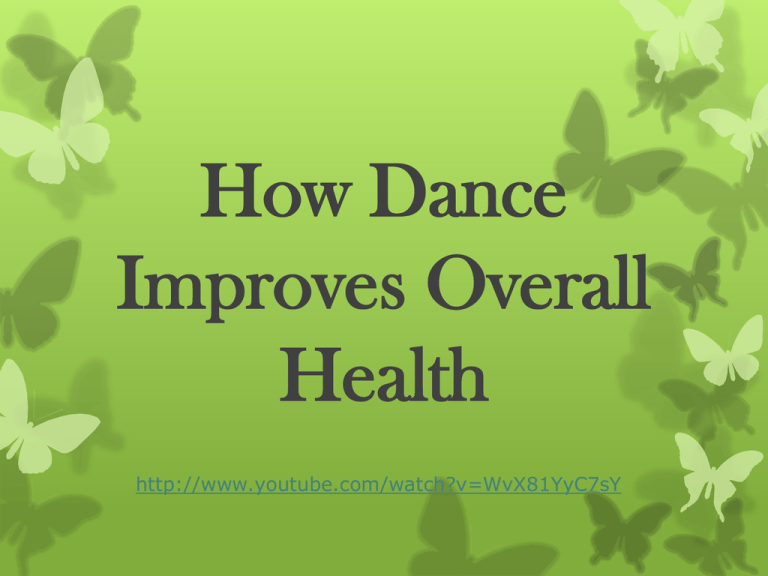PPT
advertisement

How Dance Improves Overall Health http://www.youtube.com/watch?v=WvX81YyC7sY What does it Improve? 1. Weight - lose weight, stay fit, examples 2. Diseases - Parkinson's disease, cancer, obesity, autism 3. Socially - build up self, meet people, skills 4. Mentally - Increases cognitive acuity at all ages 5. Mood - Happiness, increases self-confidence 6. Posture - Proper posture/body alignment Cancer How Dance helps: - Reduces stress Abnormal growth of cells in the body - Improves self awareness Symptoms: - Strengthens immune system - Helps anxiety & depression - Feeling of completeness - Develop positive body image Definition: - Chills - Fatigue - Weight loss - Night Sweats • Consult a doctor • Different stages • Still being studied Parkinson’s Disease How Dance helps: Definition: A disorder of the nervous system that disrupts your movement - Improve joint mobility - Improves flexibility - Improves balance - Increase walking speed - Socially Symptoms: - Tremors - Slow movement - Rigid muscles - Loss of autonomic movements Autism How dance Helps: Definition: Combination of music and dance a developmental disorder Symptoms: - Social challenges - Difficultly communicating - Repetitive behaviors - Limited interest in activities - *Dance/movement therapy - Hearing, listening, processing & repetition - Verbalizing - Improves body image Dementia Definition: How dance helps: a loss of brain function that occurs with certain diseases. - Improves cognition Symptoms: - Reduces depression - Difficulty with language - Improves physical function - Memory problem - Enhance confidence/self-esteem - Thinking and judgment(cognitive skills) - Better social skills - Emotional behavior or personality Zumba Fitness program that features Latin American dance movements Effects: - Vigorous workout - Strengthens heart - Boost mood - Loose weight - Party atmosphere Image source: www.imaginetheplace.com Ballet Gentle, tall, sharp movements that focus around French vocabulary Effects: - Improves mental ability - Improves posture - Tones Muscles - Physical - Calming Image source: http://images.fanpop.com Ballroom Dance Formal social dancing using a partner to perform European fold dances Effects: - Improves coordination - Improves posture - Improves balance - Helps depression - Low or high impact - Osteoporosis Image source: oaklandtech.com Hip-Hop Originates from street dancing that includes movements such as: breaking, locking, popping, and low to the ground and hard movements Effects: - Improves heart & lungs - Increase muscular strength - Increases endurance - Improves coordination - Improves balance - Improves confidence/esteem Belly Dance: Dance based on torso articulation—originated from the Middle East Effects: -Tones abdominal/back muscles -Improves posture -Natural hip tucks—similar to pelvic rocking taught during prenatal classes - Reduces stress Salsa: Popular form of social dance that originated in New York with strong influences from Latin America. Effects: - Builds endurance and stamina - Helps with weight loss - Relieves stress - Helps you release toxins via sweating - Reduces blood pressure - Improve cholesterol levels Jazz dance that is matched to the rhythms and techniques of jazz music, developed by American blacks in the early part of the 20th century. Effects: - Builds strong muscles - Improves posture - Improves coordination - Improves flexibility - Improves mental functioning Square Dance a dance by a set of four couples arranged in a square or in some set form. Effects: - Improves bone health - Decreases depression - Protect against Dementia - Cardiovascular fitness - Improves Better coordination, agility and flexibility Let’s Dance to the Future… Dance Therapy: Annual Conferences: - Seminars - Dancing - Networking - Dancers, artists, psychotherapists, yoga instructors www.adta.org (American dance therapy association) Let’s Dance to the Future… Dance Therapy: American Cancer Society (www.cancer.org) Coping: - Patient - Family - Caregiver - Friends Let’s Dance to the Future Dance Away Dementia - Reading - 35% reduced risk of dementia - Bicycling and swimming - 0% - Doing crossword puzzles at least four days a week 47% - Playing golf - 0% - Dancing frequently - 76%. That was the greatest risk reduction of any activity studied, cognitive or physical. http://socialdance.stanford.edu/syllabi/smarter.htm Activity https://www.youtube.com/watch?v=huO8rmrFDSc Jason dance link, start at 40sec.


